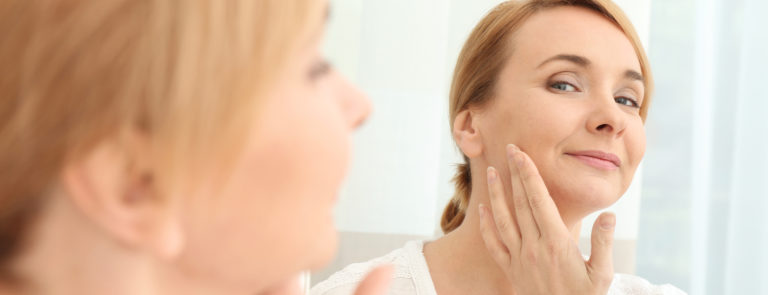15% off €35 or 20% off €45
Code:SUMMER
The gut-skin axis: how your gut health affects your skin

Whether you’re grappling with acne or you’re struggling with rosacea, find out more about how your gut can affect your skin and how to keep it happy, with expert advice from a dietician
Summary
1The link between skin and gut
“Just like with our gut, our skin shares a similar relationship where changes in the bacteria in your intestines can lead to changes..."
2Skin conditions from poor gut health
“Acne: scientists have found that an overgrowth of certain bacteria in oil-rich areas like the face can trigger inflammation...”
3Diet and lifestyle’s role in gut and skin health
“If you've ever indulged in a sugary diet only to wake up with breakouts, you'll have already experienced how diet..."
Good skin is more than just having a skincare routine. Emerging studies have found a link between the trillions of bacteria circulating in our gut and common skin issues like breakouts and irritation.1
Dubbed the ‘gut-skin axis’, this recent scientific discovery is being hailed as the next big approach in dermatology, with experts suggesting that taking a ‘beauty from the inside’ approach might yield glowing results.
So what exactly is the gut-skin axis and how can we best support it to maximise the benefits? We asked a dermatologist to give us the 411, alongside tips for giving our microbiome some TLC.
First up, how are the skin and gut linked?
When you hear the word ‘microbiome’, your mind probably wanders to funky probiotic yoghurts and other trendy supplements marketed to support gut health.
But just like the inside of our intestines, studies2 have found that our skin has its own unique microbiome that’s teeming with trillions of microscopic microorganisms.
Similarly to the gut, the bacteria and fungi crawling on your skin act as a hardy protective barrier,3 shielding you from harmful pathogens and infection. They also help break down some of the chemical nasties you encounter in daily life4 and play a crucial role in your immune system.5
But microbiome connection goes more than just skin-deep. Recently, you may have heard about something called the ‘gut-brain axis’ - the network of nerves that connects the brain and gut, enabling back-and-forth communication between the two. It’s an exciting discovery that’s reshaped how scientists approach human health, revealing strong links6 between our digestion, mood and even how we think and behave.
“In a similar way, our skin and gut also share a bidirectional relationship, where changes in the balance of bacteria in your intestines can lead to visible symptoms appearing on your skin1,” says Lucy Kerrison, a Doctify-rated dietician who specialises in gut health.
What types of skin conditions can poor gut health trigger?

Scientists have known for some time that skin complaints can often arise at the same time as gut symptoms, and vice versa.1
“There are a number of conditions where I hone in on the gut microbiome as a form of treatment, as an imbalance or overgrowth of bacteria may lead to these changes in the skin according to emerging studies,” says Lucy. These include:
- acne: scientists have found that an overgrowth of certain bacteria in oil-rich areas like the face can trigger inflammation and clogged pores, leading to breakouts7
- eczema: studies reveal that people with eczema have different bacteria in their gut compared to people without eczema;8 particularly an overgrowth of a strain called Staphylococcus aureus,9 which can cause dryness and inflammation
- rosacea: an imbalance fuelled by a H. pylori infection or ‘SIBO’ (a type of bacterial overgrowth) has been found to fuel facial redness, sensitivity and flare-ups10
- psoriasis: a weakened skin barrier and an overactive immune response, often linked to gut dysbiosis and ‘leaky gut’,11 could be the trigger for scaly psoriasis patches showing up on the skin in some people
- dandruff and seborrheic dermatitis: a 2015 review12 found that an overgrowth of yeast in oily areas like the scalp can lead to tell-tale flaking
More research is needed to know if any of these skin conditions are caused by poor gut health or exactly how it all works, but there's certainly an interesting link coming up in studies that warrants further research.
How do diet and lifestyle play a role in gut and skin health?
“We’re still uncovering how the skin and gut are linked, but one thing is becoming clear: a diverse set of bacteria with an even split between strains seems to correlate with healthier skin,”1 says Lucy.
“Anyone who has an overdominance of a certain bacteria, even if it's ‘good’ bacteria, probably won’t see that imbalance play out in a positive way,” she suggests.
If you've ever indulged in a sugary diet only to wake up with breakouts, you'll have already experienced how diet influences your skin. Some ultra-processed foods (UPFs)13 and refined sugars14 have been linked to disrupting gut bacteria and triggering skin conditions but more research is needed. Additionally, as the definition of UPFs is still hotly debated, it’s unclear which foods are included in this. So, for now, the jury is out, but why not try adding some ‘good’ bacteria to your diet found in fermented foods like kimchi.
Did you also know only 9% of us get enough fibre in our diets, a diet rich in fibre can help with digestion so why not add some more fibrous foods like lentils, beans and certain nut butters into your routine.15,16

But beyond what’s on your plate, everyday habits can also shape your microbiome and, in turn, your skin. “Not only can antibiotics17 cause big changes to the microbiome,” says Lucy. “But infections themselves, like food poisoning or picking up a bug while travelling, can also throw off bacterial balance.” And if you’re neglecting exercise18 and getting poor sleep19 at the same time? That can also inhibit skin repair and immune function.
It’s important to remember that if you do get prescribed antibiotics that you finish the course.
Burnout is another key aggravator and one that’s currently on the rise, according to the World Health Organisation.20 “Many of my clients experience stress-induced breakouts, as it causes certain bacteria to bloom and tips the gut into dysbiosis,” says Lucy. “So managing pressure at home and work is a key part of getting skin issues under control.”
A dietician’s tips for improving gut health
Alongside eliminating potential diet-based triggers, there are certain foods you should be plating up in abundance. “Oily fish like salmon and mackerel are rich in healthy fat,21” says Lucy.
Did you know that some proteins can be harder on your digestion than others? “Neutral options to consider are poultry, white fish, tofu and beans, while processed meat and red meat22 might be more challenging on your system to digest,” notes Lucy.
“If you’re experiencing skin issues, it might be useful to abstain from drinking for a while to see if alcohol is a trigger for you,” suggests Lucy. “While some studies23 have found that the polyphenols in moderate wine consumption may be beneficial for our health, many people find red wine is a huge trigger for rosacea.”
Lucy adds that fermented foods can feed your gut live microbes, which in turn, increases gut diversity.24 “I always recommend people focus on eating a portion of sauerkraut or kefir daily to help increase probiotics in the gut.”
The final say
While there are lots of home gut health tests on the market, Lucy advises speaking to your GP if your skin or gut issues persist.
They can recommend blood work, stool analysis or imaging to identify underlying conditions that could be fuelling gut issues, as well as referring you to a dermatologist to help nip any inflammatory skin conditions in the bud.
Looking to learn more about the gut? Take a look at how stress can affect your gut.
This article provides informational advice and is not a substitute for medical care. Curated by experts for accuracy, we take great care to ensure the information is up-to-date and relevant. However, you should always consult your GP or healthcare professional before using supplements or alternative products, particularly if you have medical conditions or are under supervision.
1. Mahmud MdR, Akter S, Tamanna SK, Mazumder L, Esti IZ, Banerjee S, et al. Impact of gut microbiome on skin health: gut-skin axis observed through the lenses of therapeutics and skin diseases. Gut Microbes. 2022 Jul 22;14(1).
2. Smythe P, Wilkinson HN. The Skin Microbiome: Current Landscape and Future Opportunities. International Journal of Molecular Sciences. 2023 Feb 16;24(4):3950–0.
3. Flowers L, Grice E. The Skin Microbiota: Balancing Risk and Reward. Cell Host & Microbe [Internet]. 2020 Aug 12;28(2):190–200. Available from: https://www.sciencedirect.com/science/article/abs/pii/S1931312820303589
4. Cogen AL, Nizet V, Gallo RL. Skin microbiota: a source of disease or defence? British Journal of Dermatology [Internet]. 2008 Feb 11;158(3):442–55. Available from: https://www.ncbi.nlm.nih.gov/pmc/articles/PMC2746716/
5. Nakatsuji T, Cheng JY, Gallo RL. Mechanisms for control of skin immune function by the microbiome. Current Opinion in Immunology [Internet]. 2021 Oct 1;72:324–30. Available from: https://www.sciencedirect.com/science/article/pii/S0952791521001199
6. Carabotti M, Scirocco A, Maselli MA, Severi C. The gut-brain axis: interactions between enteric microbiota, central and enteric nervous systems. Annals of Gastroenterology : Quarterly Publication of the Hellenic Society of Gastroenterology [Internet]. 2015 Apr;28(2):203. Available from: https://pmc.ncbi.nlm.nih.gov/articles/PMC4367209/
7. Lee YB, Byun EJ, Kim HS. Potential Role of the Microbiome in Acne: A Comprehensive Review. Journal of Clinical Medicine [Internet]. 2019 Jul 7;8(7):987. Available from: https://www.ncbi.nlm.nih.gov/pmc/articles/PMC6678709/
8. Chan CWH, Leung TF, Choi KC, Tsui SKW, Chan JYW. Effects of gut microbiome and environment on the development of eczema in Chinese infants. Medicine [Internet]. 2020 May 22 [cited 2021 Jun 22];99(21). Available from: https://www.ncbi.nlm.nih.gov/pmc/articles/PMC7250058/
9. George SM, Karanovic S, Harrison DA, Rani A, Birnie AJ, Bath-Hextall FJ, et al. Interventions to reduce Staphylococcus aureus in the management of eczema. Cochrane Database of Systematic Reviews. 2019 Oct 29;
10. Wang FY, Chi CC. Rosacea, Germs, and Bowels: A Review on Gastrointestinal Comorbidities and Gut–Skin Axis of Rosacea. Advances in Therapy. 2021 Jan 28;
11. De Pessemier B, Grine L, Debaere M, Maes A, Paetzold B, Callewaert C. Gut–Skin Axis: Current Knowledge of the Interrelationship between Microbial Dysbiosis and Skin Conditions. Microorganisms. 2021 Feb 11;9(2).
12. Borda LJ, Wikramanayake TC. Seborrheic Dermatitis and Dandruff: A Comprehensive Review. Journal of Clinical and Investigative Dermatology. 2015;3(2).
13. Shi Z. Gut Microbiota: An Important Link between Western Diet and Chronic Diseases. Nutrients [Internet]. 2019 Sep 24;11(10):2287. Available from: https://www.ncbi.nlm.nih.gov/pmc/articles/PMC6835660/
14. Satokari R. High Intake of Sugar and the Balance between Pro- and Anti-Inflammatory Gut Bacteria. Nutrients [Internet]. 2020 May 8;12(5):1348. Available from: https://www.ncbi.nlm.nih.gov/pmc/articles/PMC7284805/
15. Action on Fibre [Internet]. The Food & Drink Federation. Available from: https://www.fdf.org.uk/fdf/what-we-do/diet-and-health/action-on-fibre/
16. National Cancer Institute. High-Fiber Foods [Internet]. Cancer.gov. 2024. Available from: https://www.cancer.gov/about-cancer/treatment/side-effects/nutrition/high-fiber-foods
17. Patangia DV, Anthony Ryan C, Dempsey E, Paul Ross R, Stanton C. Impact of Antibiotics on the Human Microbiome and Consequences for Host Health. MicrobiologyOpen [Internet]. 2022 Jan 13;11(1). Available from: https://www.ncbi.nlm.nih.gov/pmc/articles/PMC8756738/
18. Oizumi R, Sugimoto Y, Aibara H. The Potential of Exercise on Lifestyle and Skin Function: Narrative Review. JMIR Dermatology [Internet]. 2024 Mar 14;7(1):e51962. Available from: https://derma.jmir.org/2024/1/e51962/
19. Mann C, Surajit Gorai, Staubach-Renz P, Mohamad Goldust. Sleep disorders in dermatology – a comprehensive review. Journal der Deutschen Dermatologischen Gesellschaft. 2023 May 26;21(6):577–84.
20. Bianchi R, Irvin Sam Schonfeld. Examining the evidence base for burnout. Bulletin of The World Health Organization. 2023 Nov 1;101(11):743–5.
21. Costantini L, Molinari R, Farinon B, Merendino N. Impact of Omega-3 Fatty Acids on the Gut Microbiota. International journal of molecular sciences [Internet]. 2017;18(12):2645. Available from: https://www.ncbi.nlm.nih.gov/pubmed/29215589
22. Humans IWG on the E of CR to. 4. MECHANISTIC AND OTHER RELEVANT DATA [Internet]. www.ncbi.nlm.nih.gov. International Agency for Research on Cancer; 2018. Available from: https://www.ncbi.nlm.nih.gov/books/NBK507976/
23. Bo’, Bernardi, Marino, Porrini, Tucci, Guglielmetti, et al. Systematic Review on Polyphenol Intake and Health Outcomes: Is there Sufficient Evidence to Define a Health-Promoting Polyphenol-Rich Dietary Pattern? Nutrients. 2019 Jun 16;11(6):1355.
24. Leeuwendaal NK, Stanton C, O’Toole PW, Beresford TP. Fermented Foods, Health and the Gut Microbiome. Nutrients [Internet]. 2022 Apr 6;14(7):1527. Available from: https://pubmed.ncbi.nlm.nih.gov/35406140/




